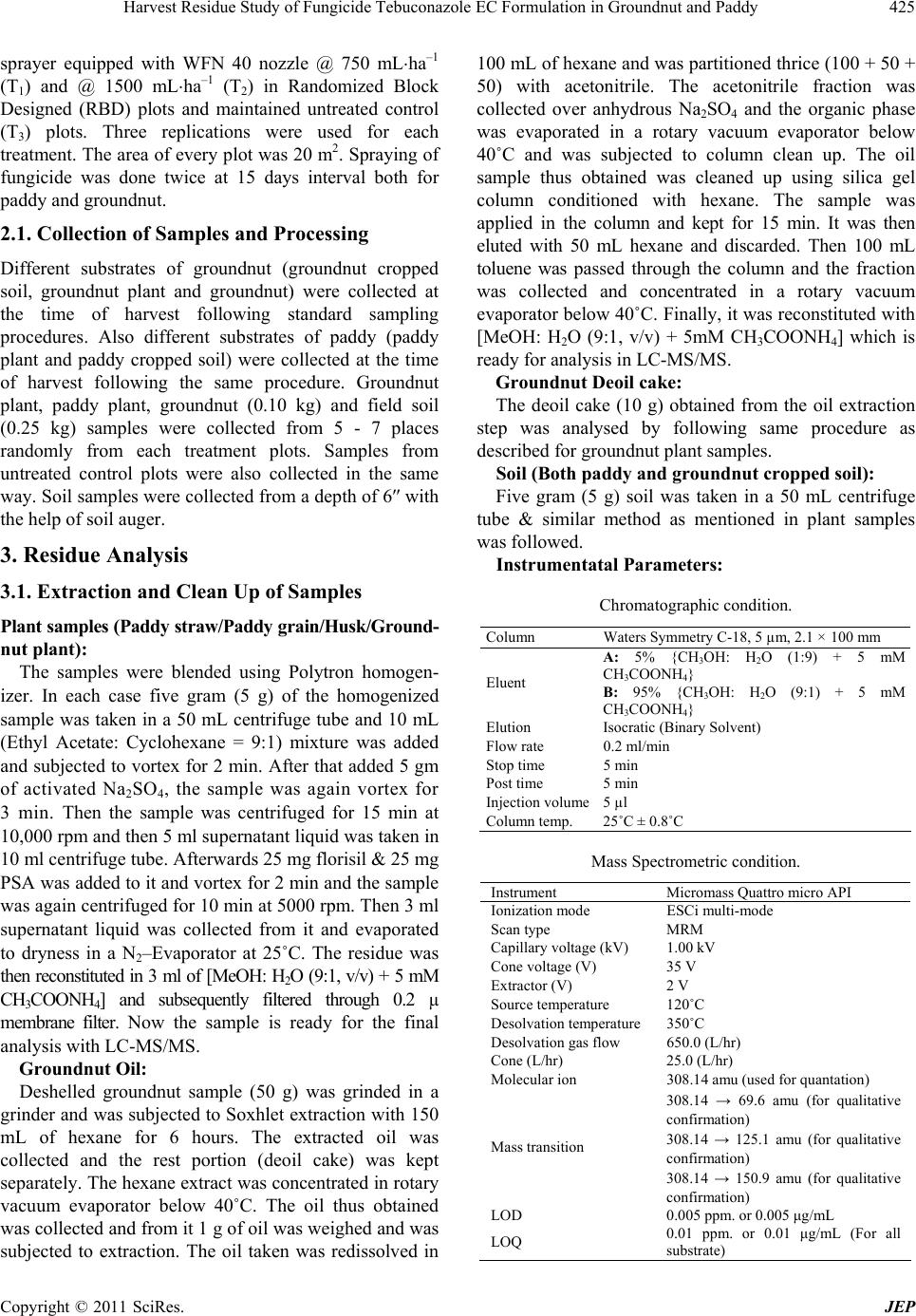
Harvest Residue Study of Fungicide Tebuconazole EC Formulation in Groundnut and Paddy425
sprayer equipped with WFN 40 nozzle @ 750 mLha–1
(T1) and @ 1500 mLha–1 (T2) in Randomized Block
Designed (RBD) plots and maintained untreated control
(T3) plots. Three replications were used for each
treatment. The area of every plot was 20 m2. Spraying of
fungicide was done twice at 15 days interval both for
paddy and groundnut.
2.1. Collection of Samples and Processing
Different substrates of groundnut (groundnut cropped
soil, groundnut plant and groundnut) were collected at
the time of harvest following standard sampling
procedures. Also different substrates of paddy (paddy
plant and paddy cropped soil) were collected at the time
of harvest following the same procedure. Groundnut
plant, paddy plant, groundnut (0.10 kg) and field soil
(0.25 kg) samples were collected from 5 - 7 places
randomly from each treatment plots. Samples from
untreated control plots were also collected in the same
way. Soil samples were collected from a depth of 6″ with
the help of soil auger.
3. Residue Analysis
3.1. Extraction and Clean Up of Samples
Plant samples ( Paddy stra w/Paddy g rain/Hu sk/Ground-
nut plant):
The samples were blended using Polytron homogen-
izer. In each case five gram (5 g) of the homogenized
sample was taken in a 50 mL centrifuge tube and 10 mL
(Ethyl Acetate: Cyclohexane = 9:1) mixture was added
and subjected to vortex for 2 min. After that added 5 gm
of activated Na2SO4, the sample was again vortex for
3 min. Then the sample was centrifuged for 15 min at
10,000 rpm and then 5 ml supernatant liquid was taken in
10 ml centrifuge tube. Afterwards 25 mg florisil & 25 mg
PSA was added to it and vortex for 2 min and the sample
was again centrifuged for 10 min at 5000 rpm. Then 3 ml
supernatant liquid was collected from it and evaporated
to dryness in a N2–Evaporator at 25˚C. The residue was
then reconstituted in 3 ml of [MeOH: H2O (9:1, v/v) + 5 mM
CH3COONH4] and subsequently filtered through 0.2 µ
membrane filter. Now the sample is ready for the final
analysis with LC-MS/MS.
Groundnut Oi l:
Deshelled groundnut sample (50 g) was grinded in a
grinder and was subjected to Soxhlet extraction with 150
mL of hexane for 6 hours. The extracted oil was
collected and the rest portion (deoil cake) was kept
separately. The hexane extract was concentrated in rotary
vacuum evaporator below 40˚C. The oil thus obtained
was collected and from it 1 g of oil was weighed and was
subjected to extraction. The oil taken was redissolved in
100 mL of hexane and was partitioned thrice (100 + 50 +
50) with acetonitrile. The acetonitrile fraction was
collected over anhydrous Na2SO4 and the organic phase
was evaporated in a rotary vacuum evaporator below
40˚C and was subjected to column clean up. The oil
sample thus obtained was cleaned up using silica gel
column conditioned with hexane. The sample was
applied in the column and kept for 15 min. It was then
eluted with 50 mL hexane and discarded. Then 100 mL
toluene was passed through the column and the fraction
was collected and concentrated in a rotary vacuum
evaporator below 40˚C. Finally, it was reconstituted with
[MeOH: H2O (9:1, v/v) + 5mM CH3COONH4] which is
ready for analysis in LC-MS/MS.
Groundnut Deoil cake:
The deoil cake (10 g) obtained from the oil extraction
step was analysed by following same procedure as
described for groundnut plant samples.
Soil (Both paddy and groundnut cropped soil):
Five gram (5 g) soil was taken in a 50 mL centrifuge
tube & similar method as mentioned in plant samples
was followed.
Instrumentatal Parameters:
Chromatographic condition.
Column Waters Symmetry C-18, 5 µm, 2.1 × 100 mm
Eluent
A: 5% {CH3OH: H2O (1:9) + 5 mM
CH3COONH4}
B: 95% {CH3OH: H2O (9:1) + 5 mM
CH3COONH4}
Elution Isocratic (Binary Solvent)
Flow rate 0.2 ml/min
Stop time 5 min
Post time 5 min
Injection volume5 µl
Column temp. 25˚C ± 0.8˚C
Mass Spectrometric condition.
Instrument Micromass Quattro micro API
Ionization mode ESCi multi-mode
Scan type MRM
Capillary voltage (kV) 1.00 kV
Cone voltage (V) 35 V
Extractor (V) 2 V
Source temperature 120˚C
Desolvation temperature 350˚C
Desolvation gas flow 650.0 (L/hr)
Cone (L/hr) 25.0 (L/hr)
Molecular ion 308.14 amu (used for quantation)
Mass transition
308.14 → 69.6 amu (for qualitative
confirmation)
308.14 → 125.1 amu (for qualitative
confirmation)
308.14 → 150.9 amu (for qualitative
confirmation)
LOD 0.005 ppm. or 0.005 μg/mL
LOQ 0.01 ppm. or 0.01 μg/mL (For all
substrate)
Copyright © 2011 SciRes. JEP